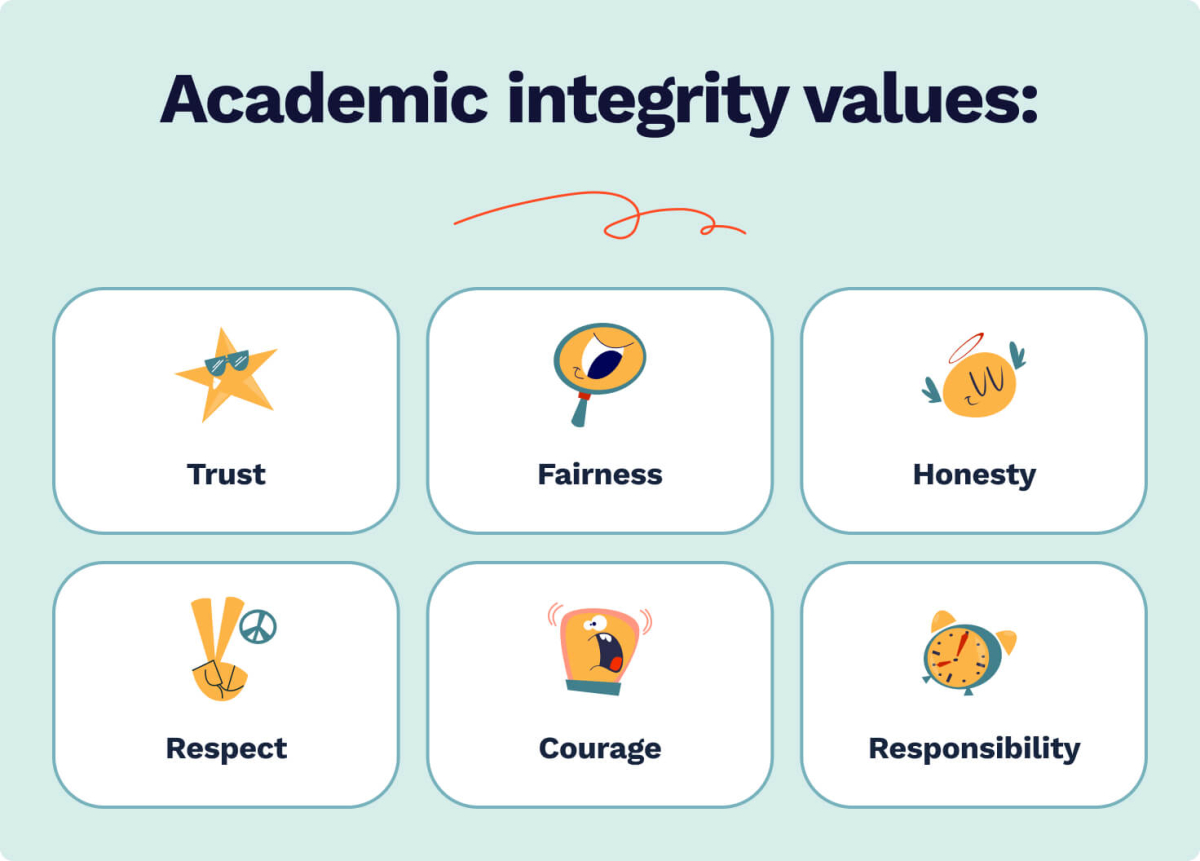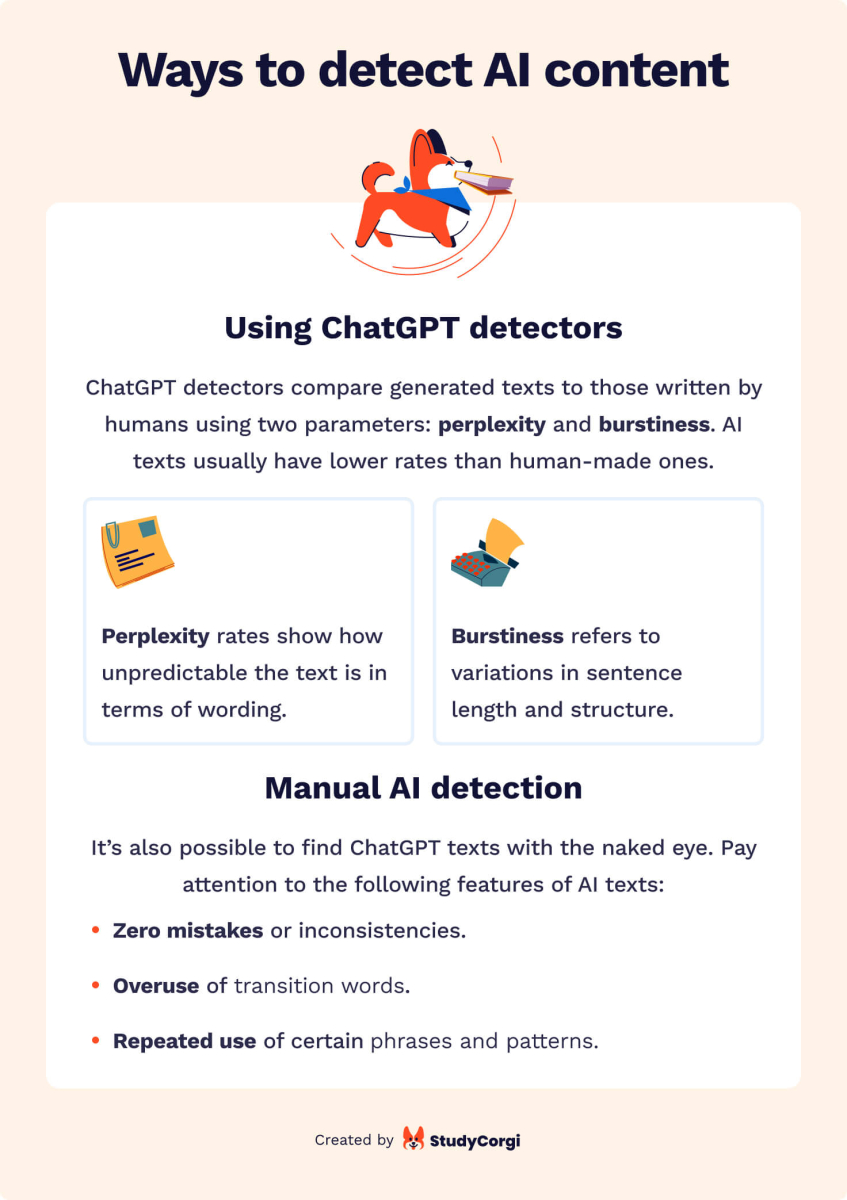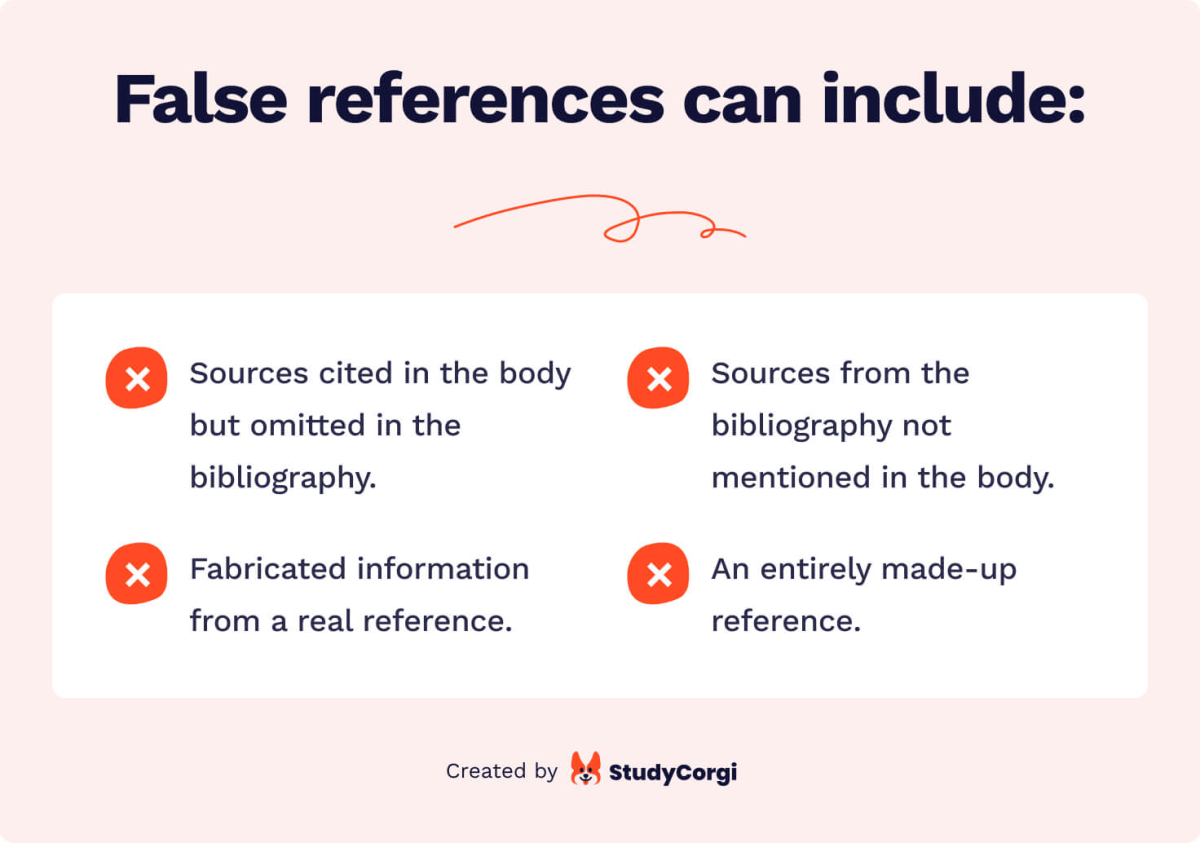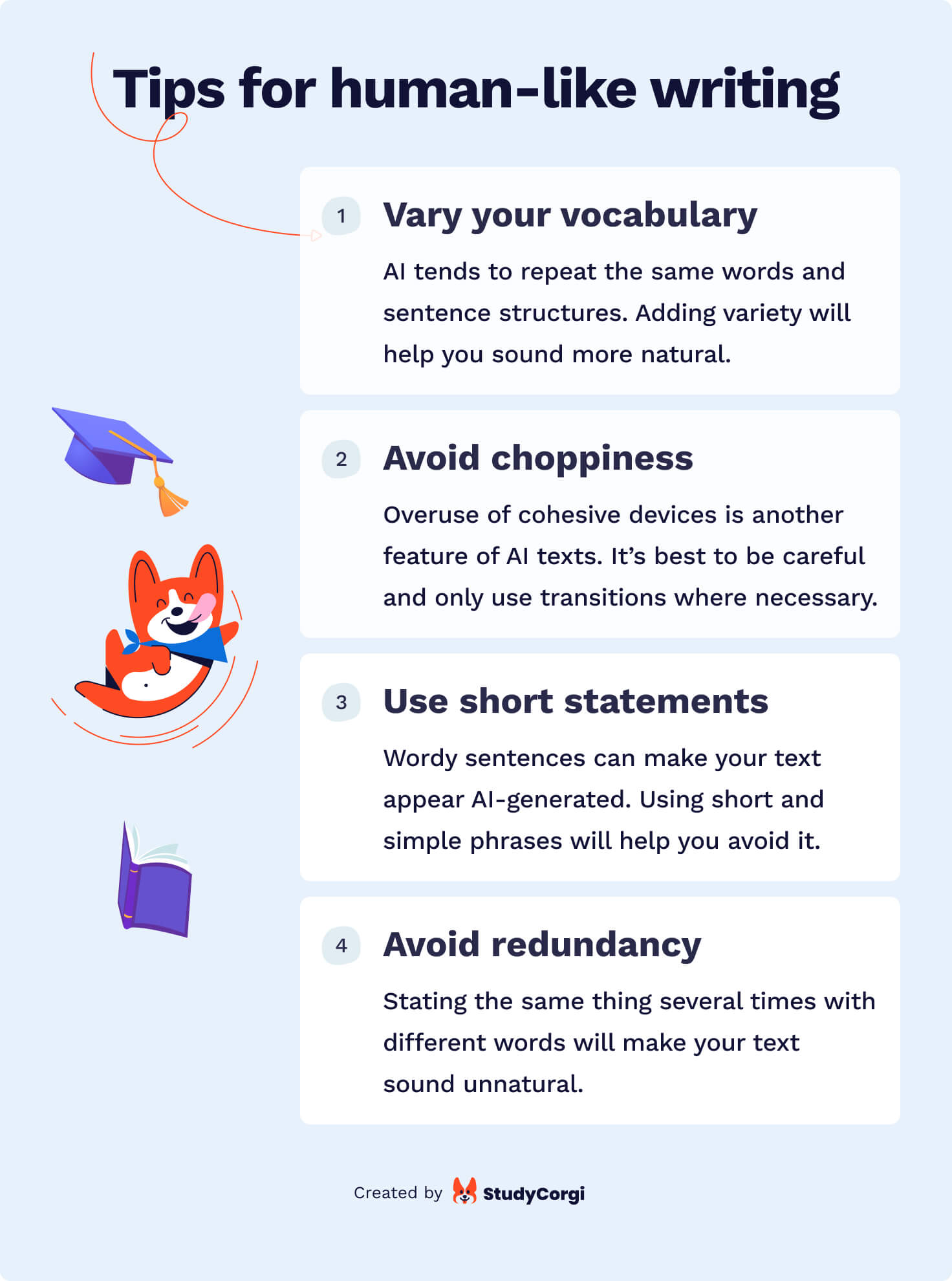AI tools such as ChatGPT can help you save time and energy when you work on your academic assignments. However, there’s always a risk of being caught or falsely accused of cheating. The consequences can be very serious and may even lead to expulsion.
So, how do you ensure your writing is human-like? Read on to find the answer!
In this article, we will tell you about the most actionable ways to avoid being accused of ChatGPT-assisted cheating.
KEY TAKEAWAYS
- Chatbot-assisted cheating goes against the principles of academic integrity.
- To avoid accusations, it’s best to be open about using AI.
- Make sure to never submit the chatbot’s texts as your own.
- You can prevent your essays from being falsely flagged as generated if you watch out for common patterns found in AI texts.
🎓 AI and Academic Integrity
A survey conducted in 2022-23 shows that nearly a third of college students use ChatGPT for schoolwork. Most of them consider it cheating but choose to go for it anyway. The ethics of AI usage are not yet clear to the majority of students, which often leads to trouble.
Here’s why:
Even though you can incorporate generated text into your work ethically, over-relying on AI tools is not the best idea since it goes against the principles of academic integrity.
What does academic integrity mean?
Well, it’s an ethical code that relies on six principles: trust, fairness, honesty, respect, courage, and responsibility. It exists to create effective scholarly communities that are credible and have a culture rooted in these values.

This is how students who use AI to do their school work violate the principles of academic integrity:
- Trust is eroded when students refuse to admit using AI to generate content.
- Fair grading is impossible when students present works that don’t demonstrate their real capabilities.
- Honesty and respect are violated whenever students present someone else’s ideas as their own without giving proper credit. This includes using AI-generated texts.
- Courage involves being unafraid to make a mistake or be not as good as your peers with your schoolwork. When students use AI to pretend they know the material better than they actually do, it doesn’t do them any favors in the long run.
- Responsibility for your work also gets violated when you delegate the writing process to AI. You can’t ensure its quality since you don’t know where the information comes from.
Teachers understand the implications of using AI irresponsibly in ways that prevent students from improving their skills. For that reason, schools have policies regarding the use of tools such as ChatGPT.
And although cheaters may believe that the chatbot’s writing is undetectable, there exist pretty accurate ways to find traces of generated text in students’ works: keep reading to learn more about them.
💡 Can Professors Detect Chat GPT?
Students who use AI for schoolwork are concerned with two questions: can you get caught using ChatGPT, and can colleges detect its usage?
The answer to both is positive. Since the chatbot’s emergence, countless students have been caught and failed their courses because they used fake citations or generated entire research papers.
For instance:
There was a case when an instructor failed 15 people in his class for generating their project milestones with AI. He was shocked to see all the international students who have struggled with English suddenly writing better than some native speakers. In addition to that, all students cited nonexistent references in their papers. As a result, the instructor had to fail a third of the class.
This is not an isolated case – according to surveys, 26% of teachers have caught at least one student using AI to cheat.
So, how do teachers determine whether ChatGPT wrote a text? Well, there are two ways to do it: checking with the naked eye and using AI detectors. Both methods rely on spotting the elements that distinguish generated texts from those written by humans.
Let’s examine these approaches in more detail.
How AI Detectors Find Generated Texts
Generative AI models such as ChatGPT are trained on large amounts of data. The same is true for detector tools. Whenever someone uploads an essay, the algorithm compares it to the texts in its database.
In particular, AI detectors look at two characteristics: perplexity and burstiness.
- Perplexity determines how unpredictable the passage is. Most of the time, AI-generated texts tend to have low perplexity – that is, they use predictable word combinations and sentence structures. In contrast, human writing tends to be more complex and unpredictable.
- Burstiness determines the variation in sentence length and structure. AI content usually has lower burstiness than human writing since it uses sentences with similar structure and length.
Even though detectors effectively recognize generated text, they don’t guarantee 100% accuracy for two reasons:
- Even though the perplexity and burstiness rates are usually lower in AI texts, humans can also write texts with predictable words and structures.
- Different ChatGPT detectors are trained on various datasets, so they often show varying percentages of AI for the same text.
Professors often double-check the text themselves to ensure accuracy in detecting AI-written content. Since they’re usually familiar with their students’ writing style, they would notice if one of them drastically changes the way they write. Also, some professors know what ChatGPT-generated texts look like, so they would likely recognize AI patterns.
This is where manual AI detection comes into play.
How Do You Detect AI Writing with the Naked Eye?
The more AI-generated texts you read, the easier it becomes to distinguish them from those written by humans. ChatGPT texts have specific features that can sound unnatural to our ears. If detectors use a mathematical approach, looking at texts with a human eye will help consider additional factors.

So, what does it mean when a text sounds unnatural? Here are some of the main reasons why a passage may feel like it’s AI-generated:
- Zero mistakes or inconsistencies.
- Overuse of transition words.
- Frequent use of fancy phrases such as “navigate the complex landscape” or “intricate web.”
- An overbearing number of present participles and lists consisting of exactly three elements.
To get a better idea of what AI texts look like, check out some examples.
🤖 Here is paragraph with two enumerations containing three elements:
E-commerce platforms, digital communication tools, and global supply chain systems have facilitated cross-border trade and collaboration. Organizations can now tap into diverse markets, access a broader talent pool, and engage with customers worldwide, fostering a more interconnected and dynamic business environment.
🤖 Here’s an example of excessive participle use:
Technological advancements have ushered in an era of automation, streamlining routine tasks and allowing businesses to allocate resources more efficiently. For instance, manufacturing processes have witnessed significant improvements through the integration of robotics, enhancing production speeds and reducing operational costs.
🤖 And here are examples of the same phrase “navigate the complex landscape” used in completely different texts:
Whether expanding into new markets or adapting to fluctuating consumer preferences, automation provides the flexibility and scalability businesses need to navigate the complex landscape of market dynamics and stay ahead of the competition.
By fostering collaboration and communication, technology empowers students to navigate the complex landscape of teamwork and interpersonal skills essential for success in the digital age.
The utilization of technology to save the environment has become increasingly imperative as humanity navigates the complex landscape of ecological challenges. In the face of climate change, habitat loss, pollution, and resource depletion, innovative technological solutions offer promising avenues for conservation and sustainability.
These texts definitely don’t look like something an average student would write. If you pay close attention to suspicious features like these, you can find generated fragments with reasonably high accuracy.
All in all, the best way to find generated texts is to use AI detectors first and then double-check by reading the paper yourself.
😱 What Happens If You Get Caught Using Chat GPT?
If you’re accused of cheating, the consequences will depend on how your school punishes such actions. Depending on how serious the accusations are, you may face one of the following:
- Failing the class. A professor can give you an F just for an assignment or a test. In worst cases, they can make you fail the entire class.
- Suspension. A student can be suspended for one or more semesters even if they were caught cheating once. In some cases, they will also be placed on academic probation, and their future submissions will be monitored more closely.
- Expulsion. This is the worst-case scenario that happens when a student has cheated several times or when the accusations are very serious.
- Damaged reputation. Using AI and being caught red-handed can negatively impact your reputation in the long run. Other colleges or companies may dismiss your application because you will appear dishonest and lazy.
It’s also important to note that cheating doesn’t always lead to failing the class or being expelled. If it’s your first time being caught, some professors may forgive you or offer you a chance to redo your work. Nevertheless, it’s best to be extra careful and avoid situations that can cause serious problems.
🚀 How to Not Get Caught Using Chat GPT in Different Situations
Some students cheat, some use AI ethically, yet some do all the work independently but are afraid of false accusations. One question unites them all: how do you not get caught using ChatGPT?
Keep reading to learn the answer and discover the best tips that actually work.
Getting Caught Generating Full Essays
Let’s start with how to avoid getting caught if you want to submit a fully-generated essay.
Well, there is no way you won’t get caught. Submitting an entirely generated paper without editing and adding something from yourself is a terrible idea. There is zero chance you won’t get caught by a teacher, even if they don’t use AI detectors.
What About AI Bypasses?
If you try to google ways to avoid getting caught, you will find many paraphrasing tools that AI cannot detect. Such solutions are usually referred to as AI bypassers. They all promise to make any text sound like a human wrote it, but do they actually work?
We’ve tested four of them: HIX, AI Text Converter, AI Converter Tool, and StudyCorgi AI Detector Bypass.
Here’s the AI text we were using:
The scientific consensus on climate change is unequivocal, and the evidence is irrefutable. Rising global temperatures, extreme weather events, melting ice caps, and shifting ecosystems are not hypothetical scenarios but the tangible manifestations of a planet in distress. Climate change is not merely an environmental issue; it is a threat multiplier.
HIX and AI Text Converter showed similar results. Both tools replaced words with their less predictable synonyms without considering the context. It made the text more unpredictable but also completely unreadable.
See for yourself:
HIX: There is no doubt among scientists that climate change is happening, and the facts are also clear. Global temperatures increase, extreme weather events, melting poles, and ecosystems that change are not just theoretical. They are concrete parts of the suffering of the earth. Climate change is not just a matter for environmentalists. It is a danger generator.
AI Text Converter: The scientific consensus on climate change is indisputable, and the evidence is incontrovertible. Rising global temperatures, extreme weather, melting ice sheets, and changing ecosystems are not fictional scenarios but the magnitude and location of a planet in danger that is tangible. Climate change is not just an environmental issue; That is a multiplier threat.
AI Converter Tool didn’t make any visible transformations to the content. The only difference was that the bot changed the Latin “e” to the corresponding Cyrillic letter. The idea is that a detector won’t label the text as AI-generated since it won’t recognize the words with the letter “e,” increasing the text’s perplexity. But if an expert were to read the paper, they would see right away that ChatGPT wrote it.
StudyCorgi AI bypass did quite well: it returned a coherent text that wasn’t marked as suspicious by a GPT detector:
The scientific consensus on climate change is unequivocal, and the evidence is irrefutable. Rising global temperatures, extreme weather events, melting ice caps, and shifting ecosystems are not hypothetical scenarios but the tangible manifestations of a planet in distress. Climate change is not merely an environmental issue; it is a threat multiplier.
So, using AI bypasses isn’t not a bad idea, but you should carefully choose the tool and meticulously check the content afterwards. Some instruments can either make the text worse or keep it the same.
Use AI Ethically
Now, what do you do if bypasses don’t work? Well, we suggest you use AI tools ethically.
For instance, you may use a case study solver to assist you with tricky aspects of analysis but still do the research yourself. Similarly, you can utilize ChatGPT to guide your work instead of generating the whole paper and submitting it as is.
One thing to remember is the importance of academic integrity and its principles:
- Always reference the authors of the sources you use. This will ensure honesty and allow you to be respectful towards the original work’s author.
- If you decide to use AI in your work, it’s best to admit it in an acknowledgment where you explain why and how you used it. This will align with the principles of trust and fairness. When you admit to using ChatGPT in your work and provide an explanation, your teachers won’t have to suspect you of cheating.
Getting Caught with Paraphrased AI Content
Let’s assume you don’t want to be a cheater, so you only use AI text for parts of your work. Additionally, you use paraphrasing tools to change the text fragments to make them unique and unpredictable.
While this may seem like a good idea, we don’t recommend using this method. Even if you paraphrase AI-generated text, using it in your paper is still considered plagiarism.
It’s also true that paraphrasing tools have serious downsides:
- Many of them are AI-based, so they don’t make your text sound less AI-like.
- Paraphrasers can substitute certain words with synonyms that are rarely used in such contexts. Such tools also tend to ignore various shades of meaning. This kind of mindless paraphrasing will only make your paper illogical and unreadable.
What to Do Instead
Again, it’s best to use the AI-generated text only as inspiration for your work. If there’s a particularly good output you want to use, try the following:
- Read it,
- Fact-check it,
- Quickly memorize the main idea,
- Express it in your own words without looking.
This way, your text will sound more natural, have your unique writing style, and show your understanding of the topic.
Doing so will also align with the principles of academic integrity. Not copying ChatGPT’s outputs mindlessly means you are ready to take responsibility for your work, which shows courage and the desire to learn.
And, of course, remember to add an acknowledgment explaining that you’ve used AI assistance. It can look like this:
I acknowledge using ChatGPT 3.5 (https://chat.openai.com) to outline this paper and proofread the first draft.
Getting Caught with AI-Generated Citations
Another situation in which students often get caught is using non-existing citations in their assignments.
When writing a paper, you should support your statements with quotes from scholarly works. Serious research may also include a literature review with detailed descriptions of relevant texts. And, of course, all works that you cite in your paper must be critically evaluated and analyzed.
Sometimes, you don’t know where an author made a particular claim, and you don’t always have time to review all the sources. In that case, the first thought may be to use AI’s assistance and find the quote in seconds. You may even ask the bot to cite the quotation in a particular format.
Don’t do that! It’s a terrible idea, and here’s why.
Suppose you’re writing an art essay, and you need to use a quotation by Sigmund Freud where he states that art is an illusion. Your prompt may look like this:
While this reply sounds very plausible, the quotation is wholly made up, and the source cites a different book that doesn’t contain “The Moses of Michelangelo.”
The phenomenon of AI making things up is known as “hallucination,” which happens very often with things like quotes and statistics.

What to Do Instead
Using fake references and citations is a severe violation of academic ethics that can have serious consequences. That’s why it’s always best to search for quotations yourself. Even though AI can save you time, it’s not worth the problems you can have if the quote turns out to be fake.
You can use AI to guide you if you’re unsure where to look for a specific passage. Use a prompt like this:
If you decide to use quotes from the internet, it’s essential to fact-check them and ensure they are real. After all, not only AI can make things up. The amount of misinformation on the information is staggering, and it’s something you should always keep in mind.
Tip: If you’ve found an interesting quotation but are not sure about its meaning, feel free to use our quote explainer – it will clarify things instantly.
Getting Caught After ChatGPT Edits Your Essay
Editing your paper with ChatGPT is one of the most ethical ways of using AI tools since the help you get from it is minimal. However, you need to be extra careful so that your text doesn’t get marked as AI-generated.
Students who use ChatGPT for editing assistance often face severe consequences and accusations of cheating. That happens because the chatbot paraphrases a text and substitutes some words with synonyms without considering context and other nuances. After that, a paper no longer sounds like human-written text but rather AI-generated content.
For example:
As you already know, “intricate web” is one of the chatbot’s favorite phrases, which is a tell-tale sign of a generated text. The passage also became too wordy and full of fluff. So, it’s obviously not worth it to delegate all editing to AI.
What to Do Instead
To avoid being accused of cheating, make sure to re-read your paper after ChatGPT edits it. Try to look at the text critically and adjust it so that it doesn’t sound like an AI has generated it.
Another helpful tip is to ask ChatGPT to list all the changes it has made to the text. This way, you’ll see how and why your work was modified.
For example, here’s what the chatbot listed for our text:
If descriptive portrayals and vivid descriptions are not what you were looking for, you can simply ignore these corrections.
Having Your Essays Falsely Flagged
Even the students who write assignments all by themselves can be mistakenly accused of cheating if their texts appear AI-like.
The best way to avoid false accusations is to provide your drafts and explain your writing process. To play safe and avoid misunderstandings, you can work in Google Documents, where the history of your edits is saved automatically. This way, teachers can trace your text’s development if needed.
Tip: Always check your texts with ChatGPT essay detector before submitting them – just to be on the safe side.
🎊 Best Tips for Undetectable Human-Like Writing
As you already know, ChatGPT uses certain words, phrases, and patterns that make it recognizable. If you don’t want your essays to appear generated, it’s essential to watch out for features characteristic of AI texts.
In the sections below, we will explain in detail how to avoid things that make your paper sound AI-like.

Steer Clear of Repetitions
When a language model like ChatGPT generates a text, it tends to use the exact words and grammatical structures within it. This makes it evident that the text is AI-made and makes the paper hard to read.
During the writing process, make sure to incorporate different sentence structures and wording to make the text more exciting and varied. It will also improve its readability.
Tip: Listening to your essays with the help of our “read my paper to me” tool will help you effectively notice any repetitiveness and eliminate it.
Avoid Choppiness
AI-generated texts may appear disjointed due to an overuse of transitions and cohesive devices, such as:
- moreover,
- furthermore,
- in addition,
- nevertheless,
- as well as,
- however,
- finally, etc.
It’s true that any text needs transitions to connect one idea to the other and create a nice flow, but AI often overuses them.
While human writers choose the words according to their contextual nuances, AI tools use them based on frequency. For that reason, if you make strange word choices or overuse certain phrases, you may be suspected of using AI. To avoid this situation, ensure you know the meaning and purpose of transitional words before using them in a text.
We also recommend reading Purdue Online Writing Lab‘s and the UNC-Chapel Hill Writing Center‘s guides to learn more about transitional devices.
Refrain from Using Wordy Statements
Another giveaway sign of an AI-created text is the overuse of contrasting and summary statements.
Here’s what it means:
- A summary statement is a brief recap of the main points.
- A contrasting statement is a comparison of two or more ideas.
These statements are wordy, and their abundance makes the paper hard to read. Most of such phrases you can substitute with simpler and shorter variants.
Take a look at the examples below to see what such statements look like and how you can replace them:
Summary statement
❌ Given the above arguments, these samples were excluded from the examination.
✔️ These samples were excluded from the examination.
Contrasting statement
❌ While it seems evident that the case was closed, further investigations took place later in the same year.
✔️ Although the case was closed, further investigations took place later in the same year.
Avoid Redundancy
Another thing that characterizes AI-generated texts is when the same thing is said twice but with different words. To avoid it, ensure you don’t repeat the same statement more than once and stay on the topic.
Here are the examples of redundant statements and how they can be changed:
Cause and effect
❌ The team won the game and became a legend to their peers as a result.
✔️ The team won the game and became a legend to their peers.
Extra words
❌ This particular complaint alleges a breach of contract by the defendant.
✔️ This complaint alleges a breach of contract by the defendant.
Linking words
❌ Despite their disagreements, however, they decided to work together on this project.
✔️ Despite the disagreements, they decided to work together on this project.
✍️ How to Not Get Caught Using ChatGPT: Summary
So, how do you avoid being caught cheating with the help of AI? Here’s a brief recap:
- Don’t try to present a generated text as your own. It’s a waste of time since AI-written essays are obviously different from the ones written by a human.
- Avoid relying on paraphrasing to make the text more human-like. Many paraphrasers are AI-based, so they won’t make your text sound natural. On the contrary, your text will become less readable and full of mistakes.
- Follow the principles of academic integrity. If you used AI for assistance while writing your paper, make sure to acknowledge it and explain why and how you used it.
- Try to minimize the use of AI in your work. It’s better to make mistakes while doing things on your own than to get caught using ChatGPT and ruin your reputation.
- Be clear and concise in your writing. AI tends to make texts more complex by overusing certain words and phrases. It’s best to avoid doing the same. Instead, clearly express your ideas and stay on topic.
And here’s a bonus tip:
Feel free to use AI-based study tools as assistance. They will help you streamline boring aspects of the writing process, leaving plenty of room for your own creativity.
Here are the best options to try out:
- Our outline maker will create a sample essay plan in seconds.
- Our speech generator is capable of generating texts specifically meant for delivering in front of an audience.
- The poem maker will help you come up with a unique poetry piece on any topic.
- The rhetorical device finder generator can locate examples of ethos, pathos, and logos even in the most difficult texts.
- Our key points generator can summarize a lengthy article or book chapter as a convenient list of main ideas.
Thanks for reading through this article! We hope you’ve found it helpful and learned something new. If you have any interesting thoughts regarding AI use and detection, feel free to share them in the comment section.
Want to learn more about using ChatGPT ethically? Check out our list of best prompts for academic writing.
